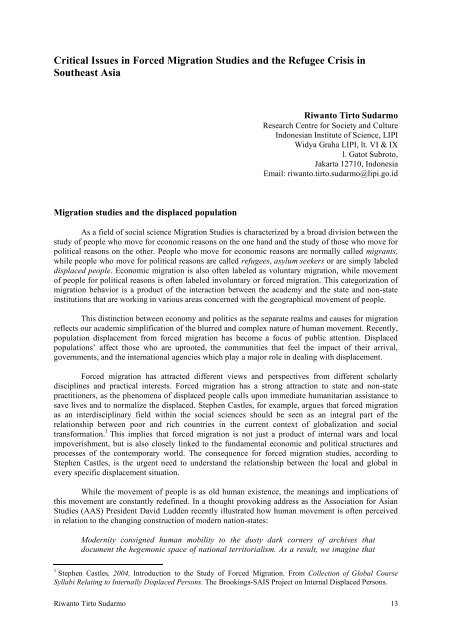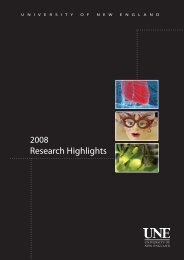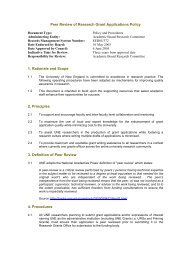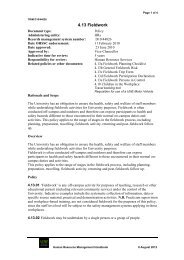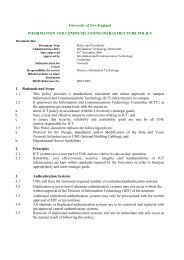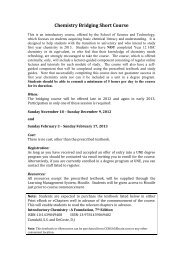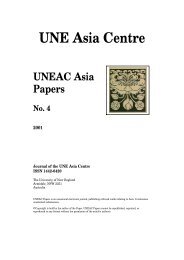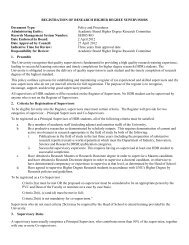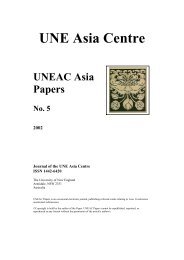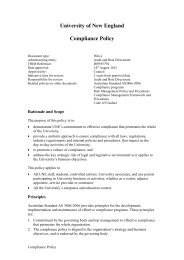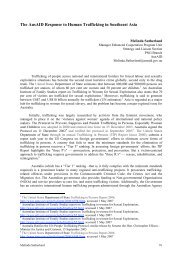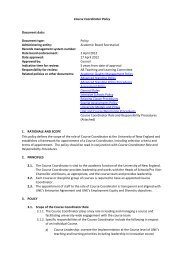Critical Issues in Forced Migration Studies and the - University of ...
Critical Issues in Forced Migration Studies and the - University of ...
Critical Issues in Forced Migration Studies and the - University of ...
Create successful ePaper yourself
Turn your PDF publications into a flip-book with our unique Google optimized e-Paper software.
<strong>Critical</strong> <strong>Issues</strong> <strong>in</strong> <strong>Forced</strong> <strong>Migration</strong> <strong>Studies</strong> <strong>and</strong> <strong>the</strong> Refugee Crisis <strong>in</strong><br />
Sou<strong>the</strong>ast Asia<br />
Riwanto Tirto Sudarmo<br />
Research Centre for Society <strong>and</strong> Culture<br />
Indonesian Institute <strong>of</strong> Science, LIPI<br />
Widya Graha LIPI, lt. VI & IX<br />
l. Gatot Subroto,<br />
Jakarta 12710, Indonesia<br />
Email: riwanto.tirto.sudarmo@lipi.go.id<br />
<strong>Migration</strong> studies <strong>and</strong> <strong>the</strong> displaced population<br />
As a field <strong>of</strong> social science <strong>Migration</strong> <strong>Studies</strong> is characterized by a broad division between <strong>the</strong><br />
study <strong>of</strong> people who move for economic reasons on <strong>the</strong> one h<strong>and</strong> <strong>and</strong> <strong>the</strong> study <strong>of</strong> those who move for<br />
political reasons on <strong>the</strong> o<strong>the</strong>r. People who move for economic reasons are normally called migrants,<br />
while people who move for political reasons are called refugees, asylum seekers or are simply labeled<br />
displaced people. Economic migration is also <strong>of</strong>ten labeled as voluntary migration, while movement<br />
<strong>of</strong> people for political reasons is <strong>of</strong>ten labeled <strong>in</strong>voluntary or forced migration. This categorization <strong>of</strong><br />
migration behavior is a product <strong>of</strong> <strong>the</strong> <strong>in</strong>teraction between <strong>the</strong> academy <strong>and</strong> <strong>the</strong> state <strong>and</strong> non-state<br />
<strong>in</strong>stitutions that are work<strong>in</strong>g <strong>in</strong> various areas concerned with <strong>the</strong> geographical movement <strong>of</strong> people.<br />
This dist<strong>in</strong>ction between economy <strong>and</strong> politics as <strong>the</strong> separate realms <strong>and</strong> causes for migration<br />
reflects our academic simplification <strong>of</strong> <strong>the</strong> blurred <strong>and</strong> complex nature <strong>of</strong> human movement. Recently,<br />
population displacement from forced migration has become a focus <strong>of</strong> public attention. Displaced<br />
populations’ affect those who are uprooted, <strong>the</strong> communities that feel <strong>the</strong> impact <strong>of</strong> <strong>the</strong>ir arrival,<br />
governments, <strong>and</strong> <strong>the</strong> <strong>in</strong>ternational agencies which play a major role <strong>in</strong> deal<strong>in</strong>g with displacement.<br />
<strong>Forced</strong> migration has attracted different views <strong>and</strong> perspectives from different scholarly<br />
discipl<strong>in</strong>es <strong>and</strong> practical <strong>in</strong>terests. <strong>Forced</strong> migration has a strong attraction to state <strong>and</strong> non-state<br />
practitioners, as <strong>the</strong> phenomena <strong>of</strong> displaced people calls upon immediate humanitarian assistance to<br />
save lives <strong>and</strong> to normalize <strong>the</strong> displaced. Stephen Castles, for example, argues that forced migration<br />
as an <strong>in</strong>terdiscipl<strong>in</strong>ary field with<strong>in</strong> <strong>the</strong> social sciences should be seen as an <strong>in</strong>tegral part <strong>of</strong> <strong>the</strong><br />
relationship between poor <strong>and</strong> rich countries <strong>in</strong> <strong>the</strong> current context <strong>of</strong> globalization <strong>and</strong> social<br />
transformation. 1 This implies that forced migration is not just a product <strong>of</strong> <strong>in</strong>ternal wars <strong>and</strong> local<br />
impoverishment, but is also closely l<strong>in</strong>ked to <strong>the</strong> fundamental economic <strong>and</strong> political structures <strong>and</strong><br />
processes <strong>of</strong> <strong>the</strong> contemporary world. The consequence for forced migration studies, accord<strong>in</strong>g to<br />
Stephen Castles, is <strong>the</strong> urgent need to underst<strong>and</strong> <strong>the</strong> relationship between <strong>the</strong> local <strong>and</strong> global <strong>in</strong><br />
every specific displacement situation.<br />
While <strong>the</strong> movement <strong>of</strong> people is as old human existence, <strong>the</strong> mean<strong>in</strong>gs <strong>and</strong> implications <strong>of</strong><br />
this movement are constantly redef<strong>in</strong>ed. In a thought provok<strong>in</strong>g address as <strong>the</strong> Association for Asian<br />
<strong>Studies</strong> (AAS) President David Ludden recently illustrated how human movement is <strong>of</strong>ten perceived<br />
<strong>in</strong> relation to <strong>the</strong> chang<strong>in</strong>g construction <strong>of</strong> modern nation-states:<br />
Modernity consigned human mobility to <strong>the</strong> dusty dark corners <strong>of</strong> archives that<br />
document <strong>the</strong> hegemonic space <strong>of</strong> national territorialism. As a result, we imag<strong>in</strong>e that<br />
1 Stephen Castles, 2004, Introduction to <strong>the</strong> Study <strong>of</strong> <strong>Forced</strong> <strong>Migration</strong>. From Collection <strong>of</strong> Global Course<br />
Syllabi Relat<strong>in</strong>g to Internally Displaced Persons. The Brook<strong>in</strong>gs-SAIS Project on Internal Displaced Persons.<br />
Riwanto Tirto Sudarmo 13
mobility is border cross<strong>in</strong>g, as though borders came first, <strong>and</strong> mobility, second. The<br />
truth is more <strong>the</strong> o<strong>the</strong>r way around 2<br />
As we see today, <strong>the</strong> state’s border is no longer meant to be a fortress for prevent<strong>in</strong>g us from<br />
external threats, or to exclude <strong>in</strong>vad<strong>in</strong>g armies, but more for keep<strong>in</strong>g economic migrants out from<br />
steal<strong>in</strong>g our peaceful life <strong>and</strong> secluded welfare.<br />
There are three dimensions <strong>in</strong>volved <strong>in</strong> <strong>the</strong> act <strong>of</strong> human movement, namely its spatial, social<br />
<strong>and</strong> temporal dimensions. The spatial dimension is related to <strong>the</strong> territorial boundaries that are crossed.<br />
In modern times, <strong>the</strong>se have taken <strong>the</strong> form <strong>of</strong> politico-adm<strong>in</strong>istrative boundaries (villages, districts,<br />
prov<strong>in</strong>ces, prefectures, counties, states, countries, nation-states, regional group<strong>in</strong>gs <strong>of</strong> nation states, i.e.<br />
EU, ASEAN, APEC, NAFTA) or political, economical or cultural constructions <strong>of</strong> geographical space<br />
(poor <strong>and</strong> rich countries, south or north countries, east <strong>and</strong> west, socialist or liberal democratic<br />
countries, develop<strong>in</strong>g, developed, <strong>in</strong>dustrial countries, Pacific Rim, etc). Coupled with this, dist<strong>in</strong>ct<br />
migratory patterns can be designated based on <strong>the</strong> period <strong>of</strong> time spent <strong>in</strong> particular group <strong>of</strong> countries<br />
that constitute a comb<strong>in</strong>ation <strong>of</strong> send<strong>in</strong>g <strong>and</strong> receiv<strong>in</strong>g countries that, at a certa<strong>in</strong> stage <strong>of</strong><br />
development, have established a dist<strong>in</strong>ctive migration system. Several categories have been created <strong>in</strong><br />
conjunction with <strong>the</strong> characteristic <strong>of</strong> <strong>the</strong> boundary that is crossed. Conventionally, movement with<strong>in</strong> a<br />
particular country is categorized as <strong>in</strong>ternal migration, whilst movement that crosses <strong>the</strong> boundaries <strong>of</strong><br />
nation states is categorized as <strong>in</strong>ternational migration.<br />
Castles 3 <strong>in</strong>troduces <strong>the</strong> idea <strong>of</strong> migration systems to <strong>in</strong>tegrate factors <strong>in</strong> an overarch<strong>in</strong>g<br />
conceptual framework which facilitates analysis <strong>of</strong> <strong>the</strong> <strong>in</strong>teractions which shape each migratory<br />
process. Such an approach implies a notion <strong>of</strong> <strong>the</strong> embeddedness <strong>of</strong> migration <strong>in</strong> broader processes <strong>of</strong><br />
economic, demographic, social, cultural <strong>and</strong> political change. <strong>Migration</strong> <strong>in</strong> this view can be seen as an<br />
<strong>in</strong>tegral part <strong>of</strong> globalization <strong>and</strong> social transformation. The key <strong>in</strong>dicator <strong>of</strong> globalization is <strong>the</strong> rapid<br />
<strong>in</strong>crease <strong>in</strong> cross-border flows <strong>of</strong> all sorts: f<strong>in</strong>ance, trade, ideas, pollution, media products <strong>and</strong> people.<br />
The key organiz<strong>in</strong>g structure for all <strong>the</strong>se flows is <strong>the</strong> transnational network, which can take <strong>the</strong> form<br />
<strong>of</strong> transnational corporations, global markets, <strong>in</strong>ternational organizations, global crim<strong>in</strong>al syndicates,<br />
or transnational cultural communities. Flows <strong>of</strong> capital <strong>and</strong> commodities are generally welcomed by<br />
<strong>the</strong> holders <strong>of</strong> economic <strong>and</strong> political power, but immigration <strong>and</strong> cultural difference are seen as<br />
potential threats to national sovereignty <strong>and</strong> identity. Yet <strong>the</strong> reality is that population mobility is<br />
<strong>in</strong>extricably l<strong>in</strong>ked with o<strong>the</strong>r types <strong>of</strong> cross-border flows.<br />
An example <strong>of</strong> <strong>the</strong> migration system is <strong>the</strong> movement <strong>of</strong> labor– mostly female domestic<br />
workers - between South <strong>and</strong> Sou<strong>the</strong>ast Asian countries to <strong>the</strong> Middle East. The migration system<br />
between <strong>the</strong> rich countries <strong>in</strong> Europe <strong>and</strong> <strong>the</strong> send<strong>in</strong>g countries <strong>in</strong> Africa, <strong>the</strong> Middle East <strong>and</strong> South<br />
Asia could be different from <strong>the</strong> migration system <strong>in</strong> East Asian countries where economic factors<br />
seem more important than politics as underly<strong>in</strong>g reasons for migration behaviors. Contemporary<br />
migration <strong>in</strong> <strong>the</strong> Americas also has different characteristics from European <strong>and</strong> East Asian systems. 4<br />
The social dimension is always embedded <strong>in</strong> <strong>the</strong> act <strong>of</strong> human movement because migration <strong>in</strong><br />
itself is a social behavior that concerns an act <strong>of</strong> a human be<strong>in</strong>g with<strong>in</strong> <strong>the</strong>ir environment. The social<br />
environment <strong>of</strong> migration is <strong>in</strong>terpreted broadly as <strong>in</strong>volv<strong>in</strong>g economics, politics <strong>and</strong> culture. An act <strong>of</strong><br />
2 David Ludden, 2003, ‘Presidential Address: Maps <strong>in</strong> <strong>the</strong> M<strong>in</strong>d <strong>and</strong> <strong>the</strong> Mobility <strong>of</strong> Asia’<br />
3 Stephen Castles, “<strong>Migration</strong> as a factor <strong>in</strong> social transformation <strong>in</strong> East Asia”, paper presented to a Conference<br />
on <strong>Migration</strong> <strong>and</strong> Development, Pr<strong>in</strong>ceton <strong>University</strong>, 4-6 May, 2000.<br />
4 Under <strong>the</strong> auspices <strong>of</strong> International Union for <strong>the</strong> Scientific Study <strong>of</strong> Population, Douglas Massey et al.<br />
produced a comprehensive study o <strong>in</strong>ternational migration <strong>in</strong> 1998. In this study a number <strong>of</strong> migration experts<br />
were appo<strong>in</strong>ted to review both <strong>the</strong> <strong>the</strong>ories <strong>and</strong> <strong>the</strong> evidences <strong>in</strong> all regions. The study could be seen as<br />
represent<strong>in</strong>g <strong>the</strong> latest state <strong>of</strong> <strong>the</strong> art <strong>of</strong> migration studies from <strong>the</strong> conventional approaches <strong>of</strong> locat<strong>in</strong>g<br />
migration <strong>in</strong> <strong>the</strong> spatio-geographical perspectives. See: Douglas S. Massey, et.al., Worlds <strong>in</strong> Motion:<br />
Underst<strong>and</strong><strong>in</strong>g International <strong>Migration</strong> at <strong>the</strong> End <strong>of</strong> <strong>the</strong> Millennium (1998)..<br />
UNEAC Asia Papers No. 14 2007 14
human movement is <strong>the</strong>refore always a movement with<strong>in</strong> <strong>the</strong> economic, political <strong>and</strong> cultural<br />
environments.<br />
The last dimension <strong>of</strong> migration is <strong>the</strong> temporal dimension. Every movement is always a<br />
movement <strong>in</strong> a particular time <strong>in</strong> history. Although <strong>the</strong> act <strong>of</strong> movement tends to be conf<strong>in</strong>ed to human<br />
movement with<strong>in</strong> a geographical space, it could also <strong>in</strong>volve a movement that might not <strong>in</strong>volve <strong>the</strong><br />
notion <strong>of</strong> space <strong>in</strong> a geographical sense but <strong>in</strong> a socio-cultural sense. In <strong>the</strong> last ten years or so<br />
migration studies has been significantly <strong>in</strong>fluenced by postmodern approaches that look upon<br />
migration as social constructions that evolve with<strong>in</strong> <strong>the</strong> processes <strong>of</strong> globalization. In this new<br />
direction migration studies are no longer isolated <strong>in</strong> conventional spatial locations but are located <strong>in</strong><br />
<strong>the</strong> wider perspectives <strong>of</strong> <strong>the</strong> politics <strong>of</strong> space. 5 In conjunction with <strong>the</strong>se new perspectives, <strong>the</strong><br />
globalization <strong>of</strong> human movement has been considered as one <strong>of</strong> <strong>the</strong> important elements <strong>in</strong> <strong>the</strong> process<br />
<strong>of</strong> de-territorializ<strong>in</strong>g <strong>of</strong> <strong>the</strong> world - those circumstances that are sometimes popularly called ‘a<br />
borderless world.’ O<strong>the</strong>r important new terms <strong>in</strong> <strong>the</strong> globalization literature that resulted from <strong>the</strong><br />
significant role <strong>of</strong> human movement <strong>in</strong> <strong>the</strong> process <strong>of</strong> transcend<strong>in</strong>g nationalities <strong>and</strong> different cultures<br />
are trans-nationalism <strong>and</strong> cosmopolitanism, <strong>in</strong> which <strong>the</strong> post-Westphalian notion <strong>of</strong> <strong>the</strong> state <strong>and</strong> its<br />
sovereignty are perceived as obsolete 6<br />
A new perspective beyond <strong>the</strong> conventional ‘Eurocentric’ framework <strong>and</strong> approach should<br />
<strong>the</strong>refore be explored <strong>and</strong> formulated to expla<strong>in</strong> <strong>the</strong> <strong>in</strong>creas<strong>in</strong>gly <strong>in</strong>terconnected migration-securitydevelopment<br />
issues that are unfold<strong>in</strong>g <strong>in</strong> <strong>the</strong> Asian region. As migration is a multidimensional notion,<br />
it is not surpris<strong>in</strong>g that it is a subject that has been studied <strong>in</strong> many academic discipl<strong>in</strong>es, most notably<br />
demography, geography, sociology <strong>and</strong> economics. The literature on migration is <strong>the</strong>refore spread<br />
across many fields. It is <strong>the</strong>refore important to bear <strong>in</strong> m<strong>in</strong>d that migration can be perceived <strong>in</strong> an<br />
eclectic mode that goes beyond any s<strong>in</strong>gle discipl<strong>in</strong>e. Yet we should also make very clear that specific<br />
discipl<strong>in</strong>ary studies <strong>of</strong> migration are very useful <strong>in</strong> our underst<strong>and</strong><strong>in</strong>g <strong>of</strong> this crucial human <strong>and</strong> that<br />
any efforts <strong>in</strong> this field should not be discouraged.<br />
<strong>Migration</strong> essentially rema<strong>in</strong>s very much <strong>the</strong> exception ra<strong>the</strong>r than <strong>the</strong> rule <strong>of</strong> human behavior.<br />
An overwhelm<strong>in</strong>gly higher number <strong>of</strong> people stay at home compared with those who migrate. Why<br />
<strong>the</strong>n does <strong>in</strong>ternational migration suddenly loom so large on <strong>the</strong> <strong>in</strong>ternational policy agenda?<br />
Accord<strong>in</strong>g to Kathleen Newm<strong>and</strong> 7 , <strong>the</strong> director <strong>of</strong> <strong>Migration</strong> Policy Institute <strong>in</strong> New York, much <strong>of</strong><br />
<strong>the</strong> answer lies <strong>in</strong> <strong>the</strong> domestic politics <strong>of</strong> migrant-receiv<strong>in</strong>g countries. Ano<strong>the</strong>r factor is <strong>in</strong> <strong>the</strong> abrupt<br />
demographic transition that <strong>the</strong> major countries <strong>of</strong> dest<strong>in</strong>ation are go<strong>in</strong>g through. Ano<strong>the</strong>r element is<br />
concerned with <strong>the</strong> consequences <strong>of</strong> human-capital flight. These <strong>and</strong> o<strong>the</strong>r factors add up to a<br />
heightened consciousness about <strong>the</strong> importance <strong>of</strong> study<strong>in</strong>g migration as a force <strong>of</strong> globalization <strong>and</strong><br />
economic change.<br />
The movement <strong>of</strong> people across geographical space can be self-motivated (voluntary) or as a<br />
result <strong>of</strong> particular circumstances that forced <strong>the</strong>m to move. In migration literature an act <strong>of</strong><br />
<strong>in</strong>voluntary movement is also known as forced migration. The circumstances that prompted an act <strong>of</strong><br />
forced migration can be ecological, social, economical <strong>and</strong> political. Political reasons for migration are<br />
particularly relevant to security issues as traditionally conceived by <strong>the</strong> field <strong>of</strong> refugee studies <strong>and</strong><br />
security studies. A body <strong>of</strong> knowledge established under <strong>the</strong> rubric <strong>of</strong> refugee studies partly resulted<br />
from <strong>the</strong> need to f<strong>in</strong>d viable solution to <strong>the</strong> burgeon<strong>in</strong>g numbers <strong>of</strong> dislocated population after <strong>the</strong> end<br />
<strong>of</strong> World War II – particularly <strong>in</strong> Europe. Accord<strong>in</strong>g to Newman (2003: 5-6) <strong>the</strong> convention relat<strong>in</strong>g to<br />
5 Emerg<strong>in</strong>g topics such as diasporas, citizenship <strong>and</strong> transnational communities are very prom<strong>in</strong>ent. See for<br />
example Peter van der Veer’s edited book on <strong>the</strong> politics <strong>of</strong> space <strong>in</strong> <strong>the</strong> South Asian Diaspora <strong>and</strong> Thomas Faist<br />
(1999) Transnationalization <strong>in</strong> International <strong>Migration</strong>: Implications for <strong>the</strong> Study <strong>of</strong> Citizenship <strong>and</strong> Culture.<br />
6 See for example Ulf Hannerz, “Notes on <strong>the</strong> Global Ecumene”, Public Culture, Vol. 1, No.2, 1989, pp.66-75<br />
<strong>and</strong> Arjun Appadurai, Modernity at Large: Cultural Dimensions <strong>of</strong> Globalization (M<strong>in</strong>neapolis: <strong>University</strong> <strong>of</strong><br />
M<strong>in</strong>nesota Press, 1996).<br />
19<br />
Kathleen Newman, “<strong>Migration</strong> as a Factor <strong>in</strong> Development <strong>and</strong> Poverty Reduction”, <strong>Migration</strong> Information<br />
Source, June 1, 2003.<br />
Riwanto Tirto Sudarmo 15
status <strong>of</strong> refugees were <strong>in</strong>itially a temporary arrangements established <strong>in</strong> <strong>the</strong> context <strong>of</strong> Cold war<br />
politics that centered on a western maneuver to underm<strong>in</strong>e <strong>the</strong> communist state by assist<strong>in</strong>g people<br />
seek<strong>in</strong>g refuge from communist countries. A conceptual challenge to <strong>the</strong> conventional underst<strong>and</strong><strong>in</strong>g<br />
<strong>of</strong> refugee -- which is conf<strong>in</strong>ed to people forced out <strong>of</strong> <strong>the</strong>ir countries for political reasons -- is <strong>the</strong><br />
<strong>in</strong>creas<strong>in</strong>g number <strong>of</strong> people who are displaced with<strong>in</strong> <strong>the</strong>ir own countries – <strong>the</strong> so called ‘<strong>in</strong>ternally<br />
displaced people’ or IDPs – that greatly outnumber refugees <strong>and</strong> asylum seekers.<br />
The critical issues brought about by <strong>the</strong> plight <strong>of</strong> <strong>the</strong> IDPs, while humanitarian <strong>in</strong> nature, have<br />
fur<strong>the</strong>r implications <strong>in</strong> relation to <strong>the</strong> legal systems that operate at <strong>the</strong> <strong>in</strong>ternational level, especially<br />
concern<strong>in</strong>g <strong>the</strong> m<strong>and</strong>ate <strong>of</strong> <strong>the</strong> UNHCR. As Castles 8 also notes, s<strong>in</strong>ce <strong>the</strong> 1980s <strong>the</strong>re has been a<br />
dramatic <strong>in</strong>crease <strong>in</strong> <strong>the</strong> frequency <strong>and</strong> severity <strong>of</strong> humanitarian crises <strong>in</strong> many parts <strong>of</strong> <strong>the</strong> world.<br />
Such developments have led to criticisms <strong>of</strong> <strong>the</strong> arrangements that exist at <strong>the</strong> <strong>in</strong>ternational levels to<br />
deal with forced migration. The <strong>in</strong>ternational refugee regime developed <strong>in</strong> <strong>the</strong> context <strong>of</strong> post-1945<br />
mass population displacement <strong>and</strong> <strong>the</strong> beg<strong>in</strong>n<strong>in</strong>gs <strong>of</strong> <strong>the</strong> Cold War. There has been considerable<br />
change <strong>in</strong> <strong>the</strong> post-Cold War period <strong>and</strong> critics argue that some <strong>of</strong> <strong>the</strong> basic assumptions <strong>and</strong> structures<br />
no longer meet current needs. This has led to constant debates about <strong>the</strong> need for reform.<br />
Accord<strong>in</strong>g to Castles, <strong>the</strong> <strong>in</strong>ternational refugee regime consists <strong>of</strong> a set <strong>of</strong> legal <strong>in</strong>struments, a<br />
number <strong>of</strong> <strong>in</strong>stitutions designed to protect <strong>and</strong> assist refugees, <strong>and</strong> a set <strong>of</strong> <strong>in</strong>ternational norms<br />
concern<strong>in</strong>g <strong>the</strong> treatment <strong>of</strong> refugees. The core <strong>of</strong> <strong>the</strong> regime is <strong>the</strong> 1951 United Nations Convention<br />
Relat<strong>in</strong>g to <strong>the</strong> Status <strong>of</strong> Refugees, which def<strong>in</strong>es who is <strong>of</strong>ficially a refugee <strong>and</strong> what rights such<br />
persons should have. The most important <strong>in</strong>stitution is <strong>the</strong> Office <strong>of</strong> <strong>the</strong> United Nations High<br />
Commissioner for Refugees (UNHCR), but many o<strong>the</strong>r <strong>in</strong>ternational organizations play a part. Many<br />
<strong>in</strong>tergovernmental agencies are <strong>in</strong>volved, <strong>in</strong>clud<strong>in</strong>g <strong>the</strong> World Food Program (WFP), <strong>the</strong> United<br />
Nations Development Program (UNDP), <strong>the</strong> United Nations Children’s Fund (UNICEF), <strong>and</strong> <strong>the</strong><br />
International Organization for <strong>Migration</strong> (IOM) <strong>and</strong> <strong>the</strong> International Committee <strong>of</strong> <strong>the</strong> Red Cross<br />
(ICRC). In addition, hundreds <strong>of</strong> NGOs play a key role. These <strong>in</strong>clude for <strong>in</strong>stance Save <strong>the</strong> Children,<br />
OXFAM, <strong>the</strong> International Rescue Committee <strong>and</strong> Médec<strong>in</strong>s Sans Frontières. States <strong>and</strong> <strong>the</strong>ir<br />
appropriate agencies as well as national humanitarian organizations may also be seen as part <strong>of</strong> <strong>the</strong><br />
regime.<br />
Recently, ano<strong>the</strong>r k<strong>in</strong>d <strong>of</strong> forced migration is enter<strong>in</strong>g <strong>the</strong> migration literature: migration<br />
where movement is a result <strong>of</strong> development programs or ‘development <strong>in</strong>duced displacement’ or<br />
DIDs. This argument is most clearly articulated by Michael Cernea, who jo<strong>in</strong>ed <strong>the</strong> World Bank <strong>in</strong><br />
1974 as its first <strong>in</strong>-house sociologist <strong>and</strong> worked as <strong>the</strong> Bank's Senior Adviser for Sociology <strong>and</strong><br />
Social Policy until 1997. His books, among o<strong>the</strong>rs Resettlement <strong>and</strong> Development (1998) <strong>and</strong> The<br />
Economics <strong>of</strong> Involuntary Resettlement: Questions <strong>and</strong> Challenges (1999) are <strong>the</strong> most comprehensive<br />
references on this topic. This perspective represents <strong>the</strong> World Bank’s response to criticisms about <strong>the</strong><br />
destructive impact <strong>of</strong> <strong>the</strong> Bank’s population resettlement projects, under which people have been<br />
displaced by Bank funded development <strong>of</strong> big dams <strong>in</strong> develop<strong>in</strong>g countries. The World Bank <strong>and</strong> <strong>the</strong><br />
IMF are <strong>the</strong> most important f<strong>in</strong>ancial organisations that represent <strong>the</strong> <strong>in</strong>terests <strong>of</strong> <strong>the</strong> rich <strong>in</strong>dustrialised<br />
countries <strong>in</strong> provid<strong>in</strong>g f<strong>in</strong>ancial <strong>and</strong> technical-economic assistance <strong>in</strong> many develop<strong>in</strong>g countries. It is<br />
through <strong>the</strong>se f<strong>in</strong>ancial organisations that ‘globalisation’ has a clear <strong>and</strong> direct impact on most <strong>of</strong> <strong>the</strong><br />
Third World population <strong>and</strong> <strong>in</strong> turn <strong>in</strong> <strong>the</strong> mak<strong>in</strong>g <strong>of</strong> <strong>the</strong> burgeon<strong>in</strong>g numbers <strong>of</strong> <strong>the</strong> displaced<br />
population <strong>in</strong> <strong>the</strong>se part <strong>of</strong> <strong>the</strong> world.<br />
Impos<strong>in</strong>g security <strong>and</strong> migration-development nexus<br />
As we enter <strong>the</strong> twenty first century, we are witness<strong>in</strong>g an alignment <strong>of</strong> security, development<br />
<strong>and</strong> migration issues <strong>in</strong> a more transparent <strong>and</strong> dynamic way than ever before. The terrorist attack on<br />
<strong>the</strong> World Trade Center on 11 <strong>of</strong> September 2001, while certa<strong>in</strong>ly a very tragic event, has no doubt<br />
provided a galvanis<strong>in</strong>g impetus for scholars work<strong>in</strong>g on security related migration issues – <strong>in</strong><br />
particular <strong>in</strong> <strong>the</strong> field <strong>of</strong> refugee studies – to seek a better underst<strong>and</strong><strong>in</strong>g <strong>of</strong> <strong>the</strong> dynamics <strong>in</strong> <strong>the</strong><br />
8 Stephen Castles, 2004Global Perspectives on <strong>Forced</strong> <strong>Migration</strong>.<br />
UNEAC Asia Papers No. 14 2007 16
elationship between migration <strong>and</strong> security. The conventional conception <strong>of</strong> security, concerned<br />
ma<strong>in</strong>ly with <strong>the</strong> security <strong>of</strong> state, is largely a political construct based ma<strong>in</strong>ly on Western European<br />
experience. 9 This heavily state-centered approach is currently under challenge as <strong>the</strong> architecture <strong>of</strong><br />
world order changes pr<strong>of</strong>oundly follow<strong>in</strong>g <strong>the</strong> end <strong>of</strong> <strong>the</strong> Cold War. This new structure is marked by<br />
<strong>the</strong> explosion <strong>of</strong> violent ethnic conflicts <strong>in</strong> fragile <strong>and</strong> failed states, <strong>the</strong> Israel-Palest<strong>in</strong>e dispute, <strong>the</strong><br />
Gulf War, <strong>and</strong> Al Qaeda’s attacks on US embassies, <strong>the</strong> WTC <strong>and</strong> <strong>the</strong> Pentagon which prompted <strong>the</strong><br />
declaration <strong>of</strong> <strong>the</strong> war on terrorism by <strong>the</strong> United States <strong>and</strong> its allies.<br />
Power relations were a crucial underly<strong>in</strong>g determ<strong>in</strong>ant <strong>in</strong> <strong>the</strong> bipolar world order <strong>of</strong> <strong>the</strong> Cold<br />
War era. Modernization <strong>the</strong>ories became ma<strong>in</strong>stream ideology <strong>in</strong> <strong>the</strong> social sciences <strong>and</strong> humanities <strong>in</strong><br />
<strong>the</strong> 1960s, flow<strong>in</strong>g <strong>in</strong>to <strong>the</strong> poor countries through developmental aid packages delivered by <strong>the</strong> rich<br />
Western-liberal countries <strong>in</strong> order to stop those poor countries from fall<strong>in</strong>g <strong>in</strong>to <strong>the</strong> h<strong>and</strong>s <strong>of</strong> <strong>the</strong><br />
socialist-communist bloc. In this bipolar world, development as an ideology as well as developmental<br />
aid packages were seen as part <strong>of</strong> <strong>the</strong> security strategy/framework <strong>of</strong> <strong>the</strong> Western liberal countries<br />
Chimni 10 , an <strong>in</strong>ternational law expert critically views <strong>the</strong> power relations between rich <strong>and</strong> poor<br />
countries by fram<strong>in</strong>g <strong>the</strong> policy regimes <strong>in</strong> <strong>the</strong> migration-development discourse <strong>in</strong>to three ‘policy<br />
logics’. By ‘policy logic’ he means <strong>the</strong> assumption underly<strong>in</strong>g sets <strong>of</strong> <strong>in</strong>terrelated <strong>in</strong>terventions by<br />
migrant-send<strong>in</strong>g countries, migrant-receiv<strong>in</strong>g countries <strong>and</strong> <strong>in</strong>ternational organizations, which <strong>in</strong><br />
aggregate may be designed a ‘migration-development regime’.<br />
The emerg<strong>in</strong>g policy regimes recognize that migration <strong>and</strong> development are l<strong>in</strong>ked, but<br />
ma<strong>in</strong>ta<strong>in</strong> <strong>the</strong> separation between migration policy <strong>and</strong> development policy. Under this logic, aid is, <strong>and</strong><br />
should be, directed only to <strong>the</strong> explicit objectives <strong>of</strong> poverty reduction, democratization, susta<strong>in</strong>able<br />
development <strong>and</strong> gender equality. Interventions towards <strong>the</strong>se goals take no account <strong>of</strong> <strong>the</strong> impacts on<br />
migration, whe<strong>the</strong>r positive or negative. At <strong>the</strong> same time, migration policy takes m<strong>in</strong>imal account <strong>of</strong><br />
<strong>the</strong> development needs <strong>of</strong> migrant-send<strong>in</strong>g countries, though <strong>the</strong>re might be some recognition <strong>of</strong> <strong>the</strong><br />
impact <strong>of</strong> bra<strong>in</strong> dra<strong>in</strong> <strong>and</strong> needs related to repatriation, for example. Interaction between development<br />
<strong>and</strong> migration policy are <strong>the</strong>refore limited to where <strong>the</strong> <strong>in</strong>terventions associated with <strong>the</strong>m overlap, as<br />
<strong>in</strong> <strong>the</strong> case <strong>of</strong> highly skilled migration, <strong>and</strong> refugee outflows from poor countries <strong>in</strong> conflict. 11<br />
Security is basically a state <strong>of</strong> be<strong>in</strong>g <strong>in</strong> which an <strong>in</strong>dividual or a community – or even a<br />
country -- feels free from any fear or threat. Feel<strong>in</strong>gs <strong>of</strong> security - or <strong>in</strong>security - are related both to <strong>the</strong><br />
physical as well as psychological well be<strong>in</strong>g. Accord<strong>in</strong>g to Johan Galtung, security is one <strong>of</strong> <strong>the</strong> basic<br />
human needs, similar to food, air <strong>and</strong> freedom. 12 As a basic need, security is essential for <strong>the</strong> existence<br />
9 Among <strong>the</strong> recent books on this <strong>the</strong>me is an edited book published by United Nations <strong>University</strong> Press<br />
‘Refugees <strong>and</strong> <strong>Forced</strong> Displacement: International Security, Human Vulnerability, <strong>and</strong> <strong>the</strong> State’ (2003). This<br />
book directly focusses on <strong>the</strong> posssible role <strong>of</strong> refugees <strong>and</strong> forced displacement – two forms <strong>of</strong> <strong>in</strong>voluntary<br />
human mobility – on state <strong>and</strong> <strong>in</strong>ternational security. A chapter on <strong>the</strong> discussion <strong>of</strong> human security by Astri<br />
Suhrke represent<strong>in</strong>g a new discourse on <strong>the</strong> security studies that attempts to shift <strong>the</strong> conventional security<br />
discourse from <strong>the</strong> state to <strong>the</strong> people is particularly <strong>in</strong>terest<strong>in</strong>g.<br />
10 B.S. Chimmi, “Aid, relief <strong>and</strong> conta<strong>in</strong>ment: The first asylum country <strong>and</strong> beyond”, Expert Work<strong>in</strong>g Paper,<br />
prepared for <strong>the</strong> Centre for Development Research study <strong>Migration</strong>-Development L<strong>in</strong>ks: Evidence <strong>and</strong> Policy<br />
Options, Copenhagen, Denmark, 2002.<br />
11 Accord<strong>in</strong>g Chimni, <strong>the</strong> three migration-development regimes <strong>and</strong> related policy logics are: 1. Closure <strong>and</strong><br />
conta<strong>in</strong>ment, aimed at control <strong>of</strong> migrants <strong>and</strong> refugees; 2. Selectivity towards immigration <strong>and</strong> development<br />
support; <strong>and</strong> 3. Liberalisation <strong>and</strong> transnationalism <strong>in</strong> <strong>the</strong> fields <strong>of</strong> labour mobility, diaspora activities, <strong>and</strong><br />
refugee protection.<br />
12 Galtung provides a thought provok<strong>in</strong>g talk <strong>in</strong> a workshop on ‘human security <strong>and</strong> area studies’, organised by<br />
Research Institute <strong>of</strong> Languages <strong>and</strong> Cultures <strong>of</strong> Asia <strong>and</strong> Africa, <strong>in</strong> Tokyo, 10 January 2004. Accord<strong>in</strong>g to<br />
Galtung <strong>the</strong> discussion on human security is <strong>in</strong> fact has long been started when <strong>the</strong> UN <strong>in</strong>troduced <strong>the</strong> concept <strong>of</strong><br />
basic human needs but this concept has lost its significance as many states are not <strong>in</strong>terested <strong>in</strong> mov<strong>in</strong>g toward<br />
more fancy concepts, such as susta<strong>in</strong>able development <strong>and</strong> later to human security. Yet, this human security<br />
concept, accord<strong>in</strong>g to Galtung, is aga<strong>in</strong> made irrelevant <strong>in</strong> <strong>the</strong> wake <strong>of</strong> <strong>the</strong> U.S. <strong>in</strong>vasion to Afghanistan <strong>and</strong> Iraq<br />
that reflects <strong>the</strong> fragility <strong>of</strong> human security <strong>in</strong> <strong>the</strong> face <strong>of</strong> violence committed by strong states towards people <strong>in</strong><br />
<strong>the</strong> weak states.<br />
Riwanto Tirto Sudarmo 17
<strong>of</strong> human be<strong>in</strong>gs. Communities <strong>and</strong> countries also need security <strong>in</strong> order to function effectively, as is<br />
<strong>the</strong> case with a sovereign state.<br />
An important feature <strong>of</strong> security studies is <strong>the</strong> perception <strong>of</strong> threat that arouses feel<strong>in</strong>gs <strong>of</strong><br />
<strong>in</strong>security. These threats can be real or imag<strong>in</strong>ary. In most cases <strong>the</strong> perceived or imag<strong>in</strong>ary threats –<br />
that br<strong>in</strong>g with <strong>the</strong>m potential or probable consequences - can be immediately transformed <strong>in</strong>to real<br />
threats when <strong>the</strong> impact <strong>of</strong> <strong>the</strong> threat is felt or experienced. The task <strong>of</strong> security analysis is to assess<br />
<strong>the</strong> probability <strong>of</strong> <strong>the</strong> transformation <strong>of</strong> perceived threats <strong>in</strong>to real threats. The notion <strong>of</strong> perception is<br />
becom<strong>in</strong>g very important <strong>in</strong> security assessments, because what is perceived as a security threat very<br />
much depends upon <strong>the</strong> various factors that <strong>in</strong>fluence <strong>the</strong> perception. This can differ from one person,<br />
or state, to ano<strong>the</strong>r. They can be related to differences <strong>in</strong> <strong>in</strong>dividual characteristics or personal<br />
preferences <strong>and</strong> <strong>in</strong>terests, such as age, gender <strong>and</strong> education; or differences <strong>in</strong> <strong>the</strong> feature <strong>of</strong> <strong>the</strong><br />
communities such as economic structures <strong>and</strong> class, political ideologies, social norms <strong>and</strong> values,<br />
religion <strong>and</strong> faith <strong>and</strong> historical experiences.<br />
Security is conventionally understood as <strong>the</strong> security <strong>of</strong> <strong>the</strong> state or country <strong>in</strong> relation to <strong>the</strong><br />
real or perceived threats from ano<strong>the</strong>r state or country. 13 Recently, <strong>the</strong> vocabulary <strong>of</strong> security has been<br />
greatly exp<strong>and</strong>ed to <strong>in</strong>clude human security <strong>and</strong> homel<strong>and</strong> security, as well as territorial security. Socalled<br />
traditional security threats have been added to by new forms <strong>of</strong> threats that are def<strong>in</strong>ed as nontraditional<br />
<strong>in</strong> nature. While Asian scholars <strong>and</strong> governments moved toward <strong>the</strong>se new security<br />
discourses <strong>and</strong> practices, governments <strong>of</strong> Western <strong>in</strong>dustrialized nations tend to be preoccupied by<br />
conventional notions <strong>of</strong> security, <strong>in</strong>clud<strong>in</strong>g <strong>the</strong> <strong>in</strong>flux <strong>of</strong> refugees <strong>and</strong> asylum seekers which <strong>the</strong>y see<br />
as threaten<strong>in</strong>g <strong>the</strong> tranquil <strong>and</strong> affluent life <strong>of</strong> <strong>the</strong>ir citizens. Yet as <strong>the</strong> process <strong>of</strong> globalization has<br />
simultaneously eroded <strong>the</strong> state’s sovereignty <strong>and</strong> fostered emerg<strong>in</strong>g awareness <strong>of</strong> global citizenship,<br />
scholars have begun to seriously question <strong>the</strong> fundamental pr<strong>in</strong>ciples <strong>of</strong> various policies <strong>and</strong><br />
regulations concern<strong>in</strong>g refugees <strong>and</strong> asylum seekers that are knock<strong>in</strong>g on <strong>the</strong> door <strong>of</strong> <strong>the</strong> rich<strong>in</strong>dustrialized<br />
countries.<br />
Mervyn Frost, for <strong>in</strong>stance, strongly argues from an ethical po<strong>in</strong>t <strong>of</strong> view that migrants<br />
(rang<strong>in</strong>g from tourists to asylum seekers) have <strong>the</strong> right to move about globally. 14 He also argues that<br />
migrants who have had <strong>the</strong>ir citizenship eroded <strong>in</strong> <strong>the</strong>ir home state ought to be seen not as supplicants<br />
deserv<strong>in</strong>g charity but as people “whom we need to establish as citizens <strong>in</strong> democratic free-states <strong>in</strong><br />
order to secure our freedom”. Significantly, Frost’s arguments highlight <strong>the</strong> ethical flaws underly<strong>in</strong>g<br />
<strong>the</strong> assumptions <strong>of</strong> most western countries’ current policies <strong>and</strong> regulations on immigration. However,<br />
it is still beyond imag<strong>in</strong>ation that his arguments will be adopted <strong>in</strong> <strong>the</strong> near future because national<br />
<strong>in</strong>terests still prevail <strong>in</strong> <strong>the</strong> most developed countries.<br />
It is very <strong>in</strong>terest<strong>in</strong>g <strong>the</strong>refore to observe <strong>the</strong> policy direction <strong>of</strong> many Asian countries that<br />
quickly adopted <strong>the</strong> so-called non traditional security concept. The political gestures <strong>of</strong> <strong>the</strong><br />
governments <strong>of</strong> Asian countries reflect <strong>the</strong>ir seriousness <strong>in</strong> realiz<strong>in</strong>g <strong>the</strong>ir new security approach. For<br />
example, <strong>the</strong> jo<strong>in</strong>t declaration between Ch<strong>in</strong>ese Premier Zhu Rongji <strong>and</strong> ASEAN leaders on<br />
cooperation <strong>in</strong> <strong>the</strong> field <strong>of</strong> non-traditional security issues dur<strong>in</strong>g <strong>the</strong> Sixth Ch<strong>in</strong>a-ASEAN Summit <strong>in</strong><br />
Phnom Penh, Cambodia, on 4 November 2002. This change reflects <strong>the</strong> responses <strong>of</strong> security experts<br />
towards <strong>the</strong> chang<strong>in</strong>g architecture <strong>of</strong> <strong>in</strong>ternational, as well as transnational relations, particularly after<br />
<strong>the</strong> Cold War <strong>and</strong> Al Qaeda’s attack on <strong>the</strong> US on 11 September, 2001. It is very clear that <strong>the</strong> 11<br />
September attacks have drastically shifted <strong>the</strong> American conception <strong>of</strong> national security. And this has<br />
13 For useful reference on <strong>the</strong> impact on globalization on security <strong>in</strong> East Asia before <strong>the</strong> event <strong>of</strong> 11 September,<br />
2001 see among o<strong>the</strong>rs Peter Van Ness ‘Globalization <strong>and</strong> Security <strong>in</strong> East Asia’, <strong>in</strong> Asian Perspective, Vol. 23,<br />
No. 4, 1999, pp. 315-342.<br />
14 Mervyn Frost, “Th<strong>in</strong>k<strong>in</strong>g ethically about refugees: A case for <strong>the</strong> transformation <strong>of</strong> global governance”, <strong>in</strong><br />
Edward Newman <strong>and</strong> Joanne van Selm (eds.), Refugees <strong>and</strong> <strong>Forced</strong> Displacement: International Security,<br />
Human Vulnerability, <strong>and</strong> <strong>the</strong> State (Tokyo: United Nations <strong>University</strong> Press, 2003), pp. 109-129.<br />
UNEAC Asia Papers No. 14 2007 18
had a pr<strong>of</strong>ound impact on <strong>the</strong> perceived architectures <strong>of</strong> world <strong>and</strong> global security, shift<strong>in</strong>g fur<strong>the</strong>r<br />
away from traditional or conventional perceptions <strong>of</strong> security <strong>and</strong> threats. 15<br />
The discourse on security is closely related to <strong>the</strong> discourse about violence, <strong>and</strong> <strong>the</strong>refore<br />
about peace. Peace is <strong>the</strong> ultimate state <strong>of</strong> be<strong>in</strong>g where <strong>in</strong>security <strong>and</strong> violence are absent. In <strong>the</strong><br />
discourse <strong>of</strong> violence, Johan Galtung differentiates between what he calls personal <strong>and</strong> structural<br />
violence. Accord<strong>in</strong>g to Galtung we shall refer to <strong>the</strong> type <strong>of</strong> violence where <strong>the</strong>re is an actor that<br />
commits <strong>the</strong> violence as personal or direct, <strong>and</strong> to violence where <strong>the</strong>re is no such actor as structural or<br />
<strong>in</strong>direct. There may not be any person who directly harms ano<strong>the</strong>r person <strong>in</strong> <strong>the</strong> structure. The<br />
violence is built <strong>in</strong>to <strong>the</strong> structure <strong>and</strong> shows up as unequal power <strong>and</strong> consequently as unequal life<br />
chances. 16 Galtung’s conception <strong>of</strong> violence as an <strong>in</strong>dication <strong>of</strong> <strong>the</strong> absence <strong>of</strong> peace is useful <strong>in</strong><br />
relation to a conception <strong>of</strong> security that is more people-centered. In this regard, <strong>the</strong> new jargon <strong>of</strong><br />
human security does not, <strong>in</strong> fact, provide any new underst<strong>and</strong><strong>in</strong>g as far as <strong>the</strong> concept <strong>of</strong> violence <strong>and</strong><br />
peace is concerned.<br />
In a very useful discussion on human security, Astri Suhrke persuasively argues that as a<br />
social construct “human security” is open to multiple <strong>in</strong>terpretations <strong>and</strong> those promot<strong>in</strong>g it are still<br />
struggl<strong>in</strong>g to formulate an authoritative <strong>and</strong> consensual def<strong>in</strong>ition. 17 Suhrke suggests that if <strong>the</strong> aim is<br />
to build a normative <strong>and</strong> policy-oriented model that places <strong>the</strong> <strong>in</strong>terest <strong>of</strong> <strong>the</strong> displaced population at<br />
<strong>the</strong> centre, a better start<strong>in</strong>g po<strong>in</strong>t is “vulnerability”. This does not evoke <strong>the</strong> same conflictual<br />
connotation as “security”. 18<br />
Refugee Crisis <strong>and</strong> <strong>the</strong> Failure <strong>of</strong> Regional Cooperation <strong>in</strong> Sou<strong>the</strong>ast Asia<br />
In a criticism <strong>of</strong> <strong>the</strong> conventional approaches to <strong>the</strong> study <strong>of</strong> Sou<strong>the</strong>ast Asia, Jan Aart Scholte<br />
(1997: 29) argued that this region should be seen with<strong>in</strong> a context <strong>of</strong> world relations:<br />
[G]lobalisation has been a primary fact <strong>of</strong> contemporary history <strong>in</strong> <strong>in</strong>sular Sou<strong>the</strong>ast<br />
Asia, deeply affect<strong>in</strong>g <strong>the</strong> politics, economics, culture, psychology, <strong>and</strong> ecology <strong>of</strong> <strong>the</strong><br />
population. The growth <strong>of</strong> global networks <strong>of</strong> social relations has been most<br />
pronounced <strong>in</strong> recent decades, but <strong>the</strong> trend can be traced back at least to <strong>the</strong> middle<br />
<strong>of</strong> <strong>the</strong> n<strong>in</strong>eteenth century. The Malay-Indonesian world, for example, does not today<br />
exist, <strong>and</strong> <strong>in</strong>deed has never existed, apart from wider world <strong>in</strong>terconnections. The<br />
student <strong>of</strong> modern-isl<strong>and</strong> Sou<strong>the</strong>ast Asia, <strong>the</strong>refore, faces a task <strong>of</strong> discover<strong>in</strong>g <strong>and</strong><br />
assess<strong>in</strong>g <strong>the</strong> <strong>in</strong>terl<strong>in</strong>kages between <strong>in</strong>ternational, national, <strong>and</strong> local circumstances<br />
that have shaped <strong>the</strong> course <strong>of</strong> social history <strong>in</strong> this region.<br />
Scholte (1997: 30) fur<strong>the</strong>r argues that:<br />
15 The change <strong>in</strong> American perceptions <strong>and</strong> attitudes towards security has meant that threat assessment, proactive<br />
law enforcement, <strong>and</strong> risk management have been augmented so as to elim<strong>in</strong>ate as much vulnerability as<br />
conceivable. This new, expansive philosophy began to take shape immediately after September 11 attacks <strong>and</strong><br />
has culm<strong>in</strong>ated <strong>in</strong> <strong>the</strong> newly creation <strong>of</strong> <strong>the</strong> Department <strong>of</strong> Homel<strong>and</strong> Security. See Jonathan Stevenson, “How<br />
Europe <strong>and</strong> America Defend Themselves”, Foreign Affairs, March-April 2003, p. 78.<br />
16 Johan Galtung, “Violence, Peace, <strong>and</strong> Peace Research”, Journal <strong>of</strong> Peace Research 6, (1969): 170-171.<br />
17 Astri Suhrke, “Human security <strong>and</strong> <strong>the</strong> protection <strong>of</strong> refugees”, <strong>in</strong> Edward Newman <strong>and</strong> Joanne van Selm<br />
(eds.), Refugees <strong>and</strong> <strong>Forced</strong> Displacement: International Security, Human Vulnerability, <strong>and</strong> <strong>the</strong> State (Tokyo:<br />
United Nations <strong>University</strong> Press, 2003), p. 100.<br />
18 It should be noted that <strong>the</strong> concept <strong>of</strong> human security was first <strong>in</strong>troduced by a task force led by Canadian’s<br />
Foreign Affairs M<strong>in</strong>ister that focused on <strong>the</strong> freedom <strong>of</strong> fear but s<strong>in</strong>ce 1997 had been re-conceptualized – mostly<br />
by Asian countries – <strong>in</strong>to <strong>the</strong> freedom from want. The idea <strong>of</strong> human security rapidly attracted many<br />
<strong>in</strong>terpretations <strong>and</strong> <strong>the</strong>re was practically no consensus on its fundamental conception. Among <strong>the</strong> good review<br />
on <strong>the</strong> contend<strong>in</strong>g perspectives <strong>of</strong> human security can be seen for example from Kanti Bajpai ‘The Idea <strong>of</strong><br />
Human security’ <strong>in</strong> International <strong>Studies</strong>, February 2003 <strong>and</strong> Rol<strong>and</strong> Paris ‘Human Security: Paradigm Shift or<br />
Hot Air?’ <strong>in</strong> International Security, Vol. 26, No. 2 (Fall 2001) pp. 87-102.<br />
Riwanto Tirto Sudarmo 19
This bl<strong>in</strong>d spot <strong>in</strong> <strong>the</strong> study <strong>of</strong> isl<strong>and</strong> Sou<strong>the</strong>ast Asia appears to reflect <strong>the</strong> power <strong>of</strong><br />
one <strong>of</strong> <strong>the</strong> ma<strong>in</strong> structures <strong>of</strong> contemporary global social relations: namely, <strong>the</strong><br />
nationality pr<strong>in</strong>ciple. As noted earlier, concurrently with <strong>the</strong> trend <strong>of</strong> globalization<br />
over <strong>the</strong> past century <strong>and</strong> more, social life <strong>in</strong> -- ga<strong>in</strong> tak<strong>in</strong>g an example <strong>of</strong> <strong>the</strong> Malay-<br />
Indonesian world -- has also become heavily nationalized. That is, at <strong>the</strong> same time<br />
that global <strong>in</strong>terconnections have <strong>in</strong>tensified <strong>in</strong> <strong>the</strong> region, national units with<br />
boundaries <strong>of</strong> previously unknown rigidity have also emerged, <strong>in</strong> <strong>the</strong> form <strong>of</strong><br />
‘Indonesia’ <strong>and</strong> ‘Malaysia’. Nationality has become a key order<strong>in</strong>g pr<strong>in</strong>ciple <strong>of</strong> world<br />
politics (e.g. <strong>in</strong> terms <strong>of</strong> national state), world economy (<strong>in</strong> regard to national<br />
currencies, national taxes, etc.), world culture (<strong>in</strong> regard to pervasive national symbols<br />
<strong>and</strong> <strong>in</strong>vented national traditions), world geography (<strong>in</strong> terms <strong>of</strong> national territories),<br />
world psychology (with notions <strong>of</strong> ‘national characters’), so on. The two tendencies,<br />
globalization <strong>and</strong> nationalization, are perhaps not so contradictory as <strong>the</strong>y may seem<br />
at first. From a world-historical perspective, <strong>the</strong> pursuit <strong>of</strong> nation-hood might be<br />
appreciated as a means by which people have attempted to ma<strong>in</strong>ta<strong>in</strong> a sense <strong>of</strong><br />
identity, community, <strong>and</strong> control <strong>of</strong> dest<strong>in</strong>y <strong>in</strong> a globaliz<strong>in</strong>g social circumstance that<br />
has tended to underm<strong>in</strong>e pre-exist<strong>in</strong>g frameworks <strong>of</strong> collective identification <strong>and</strong><br />
communal solidarity.<br />
In a different ve<strong>in</strong> Wang Gungwu (2001; 19) also argues <strong>the</strong> need to see <strong>the</strong> region as an<br />
<strong>in</strong>tegrated area ra<strong>the</strong>r than separat<strong>in</strong>g it <strong>in</strong>to different entities:<br />
With very few exceptions, <strong>the</strong> scholars avoided portray<strong>in</strong>g <strong>the</strong> local reality as <strong>in</strong>tegral<br />
parts <strong>of</strong> <strong>the</strong> unique border-less maritime world <strong>of</strong> <strong>the</strong> Malay Archipelago. In that<br />
world, people were mobile <strong>and</strong> migratory to a greater extent than we realized. It was a<br />
world <strong>of</strong> commerce, <strong>in</strong>clud<strong>in</strong>g trade over long distances. The trade was not only<br />
among <strong>the</strong> Malays <strong>the</strong>mselves, but one that, cont<strong>in</strong>uously <strong>and</strong> for centuries, attracted<br />
maritime neighbor<strong>in</strong>g peoples from <strong>the</strong> west <strong>and</strong> <strong>the</strong> north, <strong>in</strong>clud<strong>in</strong>g those from<br />
ma<strong>in</strong>l<strong>and</strong> Asia<br />
The author certa<strong>in</strong>ly is not alone <strong>in</strong> long<strong>in</strong>g for new light to be shed on studies <strong>of</strong> <strong>the</strong> region.<br />
As Benedict Anderson (1998: 7) from a different angle has argued:<br />
No o<strong>the</strong>r region <strong>of</strong> <strong>the</strong> world-not Lat<strong>in</strong> America, not <strong>the</strong> Near East, not Africa, <strong>and</strong> not<br />
South Asia-had this k<strong>in</strong>d <strong>of</strong> alarm<strong>in</strong>g pr<strong>of</strong>ile. The new hegemon was determ<strong>in</strong>ed that<br />
it not be “lost” like Ch<strong>in</strong>a. Out <strong>of</strong> this, <strong>in</strong> 1954, came SEATO (<strong>the</strong> Sou<strong>the</strong>ast Asia<br />
Treaty Organization), formed <strong>in</strong> American Manila, <strong>and</strong> later headquartered <strong>in</strong><br />
Bangkok, which was designed to save <strong>the</strong> whole postcolonial region from <strong>the</strong><br />
communist specter. In <strong>the</strong> follow<strong>in</strong>g decade, two different attempts were made by<br />
local governments <strong>in</strong> Sou<strong>the</strong>ast Asia to create regional organizations less wholly<br />
dom<strong>in</strong>ated by outsiders; both proved abortive. Only <strong>in</strong> 1967, after Sukarno had been<br />
driven from power <strong>in</strong> an orgy <strong>of</strong> mass murder, was a more permanent <strong>in</strong>stitution<br />
created: that Association <strong>of</strong> Sou<strong>the</strong>ast Asian Nations (ASEAN) which recently – after<br />
a thirty-year <strong>in</strong>terval-admitted Vietnam, Burma, Laos, <strong>and</strong> will probably <strong>in</strong>corporate<br />
Hun Sen’s Cambodia <strong>and</strong> Xanana Gusmao East Timor one day.<br />
Anderson’s comment on <strong>the</strong> politics <strong>of</strong> modern Sou<strong>the</strong>ast Asia is a rem<strong>in</strong>der <strong>of</strong> how <strong>the</strong> region<br />
will always be arena for global powers <strong>and</strong> <strong>the</strong>ir <strong>in</strong>terests.<br />
The nation-states <strong>in</strong> Sou<strong>the</strong>ast Asia emerged from a comb<strong>in</strong>ation <strong>of</strong> nationalist movement <strong>and</strong><br />
<strong>the</strong> negotiation among <strong>the</strong> former colonial powers strongly <strong>in</strong>fluenced by <strong>the</strong> United States as <strong>the</strong><br />
major superpower after <strong>the</strong> Pacific war. Follow<strong>in</strong>g <strong>the</strong> contestation between <strong>the</strong> superpowers <strong>in</strong> <strong>the</strong><br />
Cold War that clearly manifested <strong>in</strong> <strong>the</strong> Vietnam War was perhaps <strong>the</strong> first major forced population<br />
displacement <strong>in</strong> Sou<strong>the</strong>ast Asia, <strong>in</strong> which many Vietnamese decided to leave <strong>the</strong>ir countries to seek<br />
UNEAC Asia Papers No. 14 2007 20
efugees <strong>in</strong> o<strong>the</strong>r countries. The forced migration event that is epitomized by <strong>the</strong> so called ‘boat<br />
people’ could bee seen as <strong>the</strong> beg<strong>in</strong>n<strong>in</strong>g <strong>of</strong> refugee crisis <strong>in</strong> Sou<strong>the</strong>ast Asia. The flows <strong>of</strong> Vietnamese<br />
refugees <strong>in</strong>to <strong>the</strong>ir neighbor<strong>in</strong>g Sou<strong>the</strong>ast Asian countries provoked <strong>in</strong>ternational agencies <strong>and</strong> western<br />
countries to deal with this major humanitarian issue. Aga<strong>in</strong>, <strong>the</strong> north-rich countries have played a<br />
major role <strong>in</strong> solv<strong>in</strong>g <strong>the</strong> refugee crisis <strong>in</strong> Sou<strong>the</strong>ast Asia, resembl<strong>in</strong>g <strong>the</strong> experience <strong>of</strong> solv<strong>in</strong>g <strong>the</strong><br />
displaced population <strong>in</strong> Europe after <strong>the</strong> World War II.<br />
While <strong>the</strong> experience <strong>of</strong> Vietnamese boat people showed <strong>the</strong> critical role <strong>of</strong> <strong>the</strong> west <strong>in</strong> solv<strong>in</strong>g<br />
<strong>the</strong> crisis, <strong>the</strong> role <strong>of</strong> Malaysia <strong>and</strong> Indonesia <strong>in</strong> assist<strong>in</strong>g resettlement to western countries (USA,<br />
Canada, Australia) also has to be recognized. Today, <strong>the</strong> displaced populations <strong>of</strong> <strong>the</strong> upper Mekong<br />
states are almost unprotected by any states <strong>and</strong> are <strong>the</strong>refore becom<strong>in</strong>g very vulnerable. Human<br />
traffick<strong>in</strong>g is one <strong>of</strong> <strong>the</strong> major problems experienc<strong>in</strong>g by <strong>the</strong>se displaced people. <strong>Forced</strong> migration is<br />
clearly constantly l<strong>in</strong>ger<strong>in</strong>g <strong>in</strong> <strong>the</strong> life <strong>of</strong> <strong>the</strong> people that take refuge <strong>in</strong> <strong>the</strong> Thai-Vietnam-Cambodia-<br />
Laos border regions. 19<br />
While Thail<strong>and</strong> seems enjoy a perception <strong>of</strong> be<strong>in</strong>g a nation-state that has not experienced<br />
western colonialism, its east <strong>and</strong> nor<strong>the</strong>rn border regions have become <strong>the</strong> sanctuary <strong>of</strong> people that<br />
flee<strong>in</strong>g from persecution – most notably from Burma. The unresolved <strong>in</strong>ternal political problems<br />
stemm<strong>in</strong>g from <strong>the</strong> unsettled nation build<strong>in</strong>g process <strong>in</strong> Burma has become <strong>the</strong> source <strong>of</strong> protracted<br />
conflict between <strong>the</strong> military junta <strong>and</strong> <strong>the</strong> opposition group led by Aung San Suu Kyi <strong>and</strong> <strong>the</strong><br />
secessionist m<strong>in</strong>ority ethnic groups based <strong>in</strong> <strong>the</strong> border areas <strong>of</strong> Thail<strong>and</strong>. At present, thous<strong>and</strong>s <strong>of</strong><br />
displaced persons resid<strong>in</strong>g <strong>in</strong> Thai-Burma border areas <strong>and</strong> constantly call<strong>in</strong>g for both humanitarian<br />
assistance <strong>and</strong> political solution. The Muslim Roh<strong>in</strong>gas also escape <strong>and</strong> tak<strong>in</strong>g refuge <strong>in</strong> Malaysia<br />
from political persecution <strong>in</strong> <strong>the</strong>ir home Burma. The Malaysian government seems more tolerant<br />
toward Muslim refugees, especially <strong>the</strong> Roh<strong>in</strong>gas, <strong>and</strong> to a lesser extent <strong>the</strong> Acehnese <strong>and</strong> Patanis. The<br />
unf<strong>in</strong>ished project <strong>of</strong> nation build<strong>in</strong>g <strong>in</strong> <strong>the</strong> post-colonial states <strong>of</strong> Sou<strong>the</strong>ast Asia also flare up <strong>in</strong> <strong>the</strong><br />
Sou<strong>the</strong>rn Philipp<strong>in</strong>e <strong>of</strong> M<strong>in</strong>danao isl<strong>and</strong>s, Indonesia’s West Papua <strong>and</strong> Aceh, <strong>and</strong> recently <strong>in</strong> sou<strong>the</strong>rn<br />
Thail<strong>and</strong>. These conflict hot spots have produced both refugees <strong>and</strong> <strong>in</strong>ternally displaced populations<br />
that strongly reflect <strong>the</strong> failure <strong>of</strong> Sou<strong>the</strong>ast Asian states <strong>in</strong> deal<strong>in</strong>g with <strong>the</strong>ir own domestic politics<br />
<strong>and</strong> <strong>the</strong>ir <strong>in</strong>ter-state issues, especially with regard to <strong>the</strong> problem <strong>of</strong> cross border forced population<br />
movement. 20 The Sou<strong>the</strong>ast Asian border areas now represent a specter <strong>of</strong> forced population<br />
displacement arenas <strong>in</strong> which various refugee related issues such as <strong>the</strong> statelessness, citizenships,<br />
human traffick<strong>in</strong>g <strong>and</strong> identity politics are call<strong>in</strong>g for better rigorous academic underst<strong>and</strong><strong>in</strong>g <strong>and</strong><br />
viable policy options.<br />
The discourse on <strong>the</strong> so-called ‘<strong>in</strong>ternally displaced populations’ <strong>in</strong> <strong>the</strong> region is relatively<br />
new. In <strong>the</strong> Indonesian <strong>and</strong> Philipp<strong>in</strong>e language, for example, <strong>the</strong> terms that are used is ‘pengungsi’<br />
(Indonesia) <strong>and</strong> ‘bakwit’ (Philipp<strong>in</strong>e) or ‘refugee’ if we translate <strong>in</strong>to English language. 21 While <strong>in</strong> <strong>the</strong><br />
<strong>in</strong>ternational community <strong>the</strong> term ‘refugee’ constitutes a totally different mean<strong>in</strong>g to that implied by<br />
<strong>the</strong> phrase ‘<strong>in</strong>ternally displaced population’, <strong>in</strong> <strong>the</strong> Indonesian context ‘pengungsi’ is used<br />
<strong>in</strong>terchangeably, mean<strong>in</strong>g people that are tak<strong>in</strong>g refuge <strong>in</strong> a (temporary) safe place if <strong>the</strong>y were forced<br />
to move from <strong>the</strong>ir usual residence. The reasons for <strong>the</strong>ir move range from natural disasters<br />
(earthquake, eruption <strong>of</strong> <strong>the</strong> mounta<strong>in</strong>) or man made disasters (flood<strong>in</strong>g, development projects, <strong>and</strong><br />
governments’ eviction from public areas, communal conflicts, <strong>and</strong> war). The forcefulness <strong>of</strong><br />
circumstances that <strong>in</strong>stigate <strong>the</strong> movement constitute <strong>the</strong> ma<strong>in</strong> characteristic <strong>of</strong> <strong>the</strong> ‘pengungsi’<br />
phenomena. Look<strong>in</strong>g from this broader underst<strong>and</strong><strong>in</strong>g <strong>of</strong> <strong>the</strong> causes <strong>of</strong> movement, <strong>the</strong> so-called<br />
19 See Anh Dang Nguyen, 2004, “<strong>Forced</strong> <strong>Migration</strong> <strong>in</strong> Vietnam: Historical <strong>and</strong> Contemporary Perspectives”.<br />
20 The latest <strong>in</strong>cidence <strong>in</strong> mid January 2006 concern<strong>in</strong>g <strong>the</strong> arrival <strong>of</strong> 43 peoples (36 adults <strong>and</strong> 7childrens) <strong>of</strong><br />
West Papuans by boat <strong>in</strong> Far North Queensl<strong>and</strong> seek<strong>in</strong>g asylum <strong>in</strong> Australia is case <strong>in</strong> po<strong>in</strong>t. Australia as <strong>the</strong><br />
signatory <strong>of</strong> <strong>the</strong> 1951 Convention <strong>and</strong> <strong>the</strong> 1967 Protocol relat<strong>in</strong>g to <strong>the</strong> Status <strong>of</strong> Refugees is obliged to process<br />
<strong>the</strong> future refugee status <strong>of</strong> <strong>the</strong>se people. The case however will likely to be h<strong>and</strong>led by <strong>the</strong> Australian very<br />
carefully to avoid <strong>the</strong> irritat<strong>in</strong>g reaction from <strong>the</strong> Indonesian government.<br />
21 On <strong>the</strong> ‘bakwit’ <strong>and</strong> <strong>the</strong> displaced population <strong>in</strong> M<strong>in</strong>danao, The Philipp<strong>in</strong>e, see an <strong>in</strong>terest<strong>in</strong>g study by<br />
Canuday, 2004.<br />
Riwanto Tirto Sudarmo 21
‘<strong>in</strong>ternally displaced population’ could be someth<strong>in</strong>g that is noth<strong>in</strong>g new <strong>in</strong> Indonesia (before <strong>and</strong> after<br />
<strong>in</strong>dependence). 22<br />
The sense <strong>of</strong> newness that is <strong>in</strong>voked <strong>in</strong> <strong>the</strong> recent discourse on ‘<strong>in</strong>ternally displaced<br />
populations’ is perhaps related to <strong>in</strong>tervention by <strong>in</strong>ternational agencies, particularly <strong>the</strong> UN <strong>of</strong>fices <strong>in</strong><br />
state’s capital, that attempt to deal with <strong>the</strong> vastly <strong>in</strong>creased numbers <strong>of</strong> ‘pengungsi’ as a result <strong>of</strong><br />
political conflicts In <strong>the</strong> beg<strong>in</strong>n<strong>in</strong>g <strong>of</strong> 1992 Frances Deng appo<strong>in</strong>ted as a special secretary to <strong>the</strong> UN<br />
secretary general on IDPs. S<strong>in</strong>ce <strong>the</strong>n <strong>the</strong> idea <strong>of</strong> IDPs has quickly entered public discourses as various<br />
<strong>in</strong>stitutions, both foreign <strong>and</strong> local, beg<strong>in</strong> to follow <strong>the</strong> UN’s steps <strong>in</strong> ‘capitaliz<strong>in</strong>g’ <strong>the</strong> plight <strong>of</strong><br />
‘displaced people’ that flourishes as communal conflicts become one facet <strong>in</strong> <strong>the</strong> wider canvas <strong>of</strong><br />
‘political transition toward democracy’ <strong>in</strong> Indonesia.<br />
IDPs (<strong>in</strong> <strong>the</strong> <strong>in</strong>ternational usage) or ‘pengungsi’ (<strong>in</strong> local or national usage) have attracted<br />
‘development practitioners’ both from with<strong>in</strong> <strong>and</strong> without ‘<strong>of</strong>ficial circles’ add<strong>in</strong>g <strong>in</strong>to a long list <strong>of</strong><br />
so-called vulnerable groups that have long been part <strong>of</strong> <strong>the</strong> vocabulary <strong>in</strong> <strong>the</strong> development discourse<br />
<strong>and</strong> practices <strong>in</strong> Indonesia. Aga<strong>in</strong>, <strong>in</strong> this context we have noticed <strong>the</strong> development <strong>of</strong> a particular term<br />
that is closely related to <strong>the</strong> <strong>in</strong>ternationalization <strong>of</strong> <strong>the</strong> concept <strong>and</strong> <strong>the</strong> <strong>in</strong>terconnected events which<br />
occur at <strong>the</strong> global level. 23 Yet, we also notice <strong>the</strong> strong connotation <strong>of</strong> bureaucratic tones embedded<br />
with<strong>in</strong> <strong>the</strong> concept <strong>and</strong> <strong>the</strong> term<strong>in</strong>ologies that are used. Such circumstances should <strong>the</strong>refore be<br />
critically analyzed as <strong>the</strong> programmatic approaches that follows can be actually remote from what is<br />
genu<strong>in</strong>ely needed by <strong>the</strong> displaced people. 24 The displaced people -- regardless <strong>of</strong> <strong>the</strong> causes that force<br />
<strong>the</strong>m to migrate -- are basically people that live <strong>in</strong> vulnerable economic, social <strong>and</strong> political<br />
circumstances. The critical feature <strong>in</strong> this event, however, is <strong>the</strong> process <strong>of</strong> how human be<strong>in</strong>gs are<br />
compelled to be dispossessed – <strong>of</strong> <strong>the</strong>ir material as well as social <strong>and</strong> cultural belong<strong>in</strong>gs. The<br />
dispossession process <strong>in</strong> fact is <strong>the</strong> heart <strong>of</strong> any form <strong>of</strong> forced displacement.<br />
While <strong>the</strong> press<strong>in</strong>g needs <strong>of</strong> displaced people always have to be given immediate priority,<br />
<strong>the</strong>re are several more fundamental matters that should be given serious attention both by scholars <strong>and</strong><br />
practitioners if long-term <strong>and</strong> viable solutions are to be reached <strong>in</strong> deal<strong>in</strong>g with displaced populations<br />
<strong>in</strong> Sou<strong>the</strong>ast Asia. The forcefulness <strong>of</strong> circumstances that produce displaced populations should be<br />
seen as part <strong>of</strong> <strong>the</strong> longer processes <strong>of</strong> as yet unf<strong>in</strong>ished <strong>and</strong> perhaps failed nation-state build<strong>in</strong>g,<br />
whereby some groups <strong>of</strong> people are firstly dispossessed <strong>the</strong>n secondly displaced. As <strong>the</strong> displaced<br />
constitute a dispossessed group <strong>of</strong> people, <strong>the</strong>n <strong>the</strong> more fundamental issues are <strong>the</strong>refore related to<br />
<strong>the</strong> needs <strong>in</strong> recover<strong>in</strong>g what have been lost: <strong>the</strong>ir political rights, <strong>the</strong>ir property rights <strong>and</strong> <strong>the</strong>ir<br />
cultural rights. Look<strong>in</strong>g from this broader perspective what we should envisioned is perhaps an<br />
approach that could genu<strong>in</strong>ely provide room to convey <strong>the</strong> creation <strong>of</strong> <strong>the</strong>se displaced people’s own<br />
perspectives. In order to facilitate <strong>the</strong> creation <strong>of</strong> such a perspective, <strong>the</strong> discourse on refugees <strong>and</strong><br />
displaced peoples <strong>in</strong> <strong>the</strong> Sou<strong>the</strong>ast Asian region should be critically assessed <strong>and</strong> shifted from <strong>the</strong><br />
current heavily adopted programmatic approaches. As Nordstrom <strong>and</strong> Mart<strong>in</strong> (1992: 15) correctly<br />
note, ‘social scientists, no matter what <strong>the</strong>ir field <strong>of</strong> study, will <strong>in</strong> all likelihood confront some <strong>in</strong>stance<br />
<strong>of</strong> sociopolitical violence <strong>in</strong> <strong>the</strong> field’ <strong>and</strong> <strong>the</strong>y need ‘viable field methodologies <strong>and</strong> <strong>the</strong>oretical<br />
frameworks’ if <strong>the</strong>y are to underst<strong>and</strong> <strong>the</strong> processes that <strong>in</strong>volve <strong>the</strong>m as possible victims as well as<br />
observers. 25<br />
22 See Hugo’s (1981) types <strong>of</strong> conflict <strong>in</strong>itiat<strong>in</strong>g refugee movements, with examples from South-East Asia<br />
(ma<strong>in</strong>ly Indonesia). Accord<strong>in</strong>g to Hugo <strong>the</strong>re are n<strong>in</strong>e types <strong>of</strong> conflict <strong>in</strong>itiat<strong>in</strong>g refugee movements: 1.<br />
<strong>in</strong>dependence struggles, 2. Ethnic conflicts with autonomy/separatist dimensions, 3. <strong>in</strong>ternal ethnic conflict not<br />
related to separatist/autonomy struggles, 4. class conflict, 5. <strong>in</strong>ter-elite power struggles, 6. state-<strong>in</strong>tervention<br />
conflicts, 7. <strong>in</strong>ternational wars, 8. religious-based conflicts, 9. colonial-based conflicts.<br />
23 Indonesia is one <strong>of</strong> <strong>the</strong> country <strong>in</strong> which <strong>the</strong> UN gave special attention, see report on <strong>the</strong> Sem<strong>in</strong>ar on ‘Internal<br />
Displacement <strong>in</strong> Indonesia: Toward an Integrated Approach’, co-organised by <strong>the</strong> UN <strong>and</strong> several national <strong>and</strong><br />
<strong>in</strong>ternational organisastions, June 26-27, 2001.<br />
24 On <strong>the</strong> critical analysis <strong>of</strong> <strong>the</strong> dom<strong>in</strong>ant <strong>of</strong>ficial discourse on <strong>in</strong>ternally displaced people, Sorensen (2002)<br />
provides a useful example based on her anthropological study <strong>of</strong> displaced population <strong>in</strong> Srilanka.<br />
25 Quoted from Shanmugaratnam et.al., 2003, In <strong>the</strong> Maze <strong>of</strong> Displacement.<br />
UNEAC Asia Papers No. 14 2007 22
Conclud<strong>in</strong>g remarks<br />
In <strong>the</strong> aftermath <strong>of</strong> <strong>the</strong> Cold War era, <strong>the</strong> movement <strong>of</strong> people has entered a new phase.<br />
Interstate wars have produced displaced populations, many spill<strong>in</strong>g <strong>in</strong>to neighbor<strong>in</strong>g countries or<br />
oscillat<strong>in</strong>g with<strong>in</strong> border areas. In <strong>the</strong>se new political circumstances studies on population movement<br />
can no longer based on <strong>the</strong> narrow conventional <strong>the</strong>oretical framework emanat<strong>in</strong>g from modernization<br />
<strong>the</strong>ories <strong>and</strong> approaches. The <strong>in</strong>creas<strong>in</strong>g magnitude <strong>of</strong> forced displacement as people escape from<br />
violence (that <strong>in</strong> many <strong>in</strong>stances resulted from a state’s failure <strong>in</strong> conflict resolution) critically<br />
challenges <strong>the</strong> conventional study on migration that has generally neglected political <strong>and</strong> security<br />
issues. The previous study on forced migration, ma<strong>in</strong>ly devoted to refugee issues, is also critically<br />
challenged as displaced populations exist with<strong>in</strong> state borders. While <strong>the</strong> movement <strong>of</strong> people from <strong>the</strong><br />
south to <strong>the</strong> rich-north countries constitutes a comb<strong>in</strong>ation <strong>of</strong> forced <strong>and</strong> economic migration, it has<br />
become more complex as identity politics becomes entrenched. The <strong>in</strong>creas<strong>in</strong>g terrorism target<strong>in</strong>g <strong>the</strong><br />
United States <strong>and</strong> its allies reflect a complex mixture <strong>of</strong> global migration, <strong>in</strong>equalities based on<br />
different cultural identities, <strong>and</strong> security. The tighten<strong>in</strong>g state’s border control <strong>and</strong> <strong>the</strong> <strong>in</strong>tensify<strong>in</strong>g <strong>of</strong><br />
surveillance <strong>of</strong> immigrant groups <strong>and</strong> foreign workers constitute <strong>the</strong> new complex nexus <strong>of</strong> migration,<br />
security <strong>and</strong> global politics.<br />
From a narrow academic perspective, <strong>the</strong> displaced population is divided <strong>in</strong>to three broad<br />
categories. The first is related to violent conflicts; <strong>the</strong> second is caused by state’s development policy<br />
<strong>and</strong> programs, <strong>and</strong> third results from massive natural disasters. Although different labels apply<br />
differently to different categories, this typology basically represents forced migrant populations that<br />
take refuge <strong>in</strong> a safe place outside <strong>the</strong>ir habitual residence. In Sou<strong>the</strong>ast Asia, <strong>in</strong>ternal conflict that has<br />
produced <strong>in</strong>ternally displaced populations <strong>and</strong> refugees that fill or cross state borders <strong>of</strong>ten mirrors <strong>the</strong><br />
conflict between local elites or different factions <strong>in</strong> <strong>the</strong> national government, imply<strong>in</strong>g tensions <strong>in</strong><br />
grassroots levels. The <strong>in</strong>volvement <strong>of</strong> a state’s security apparatus <strong>in</strong> areas <strong>of</strong> conflict show that <strong>the</strong><br />
state is <strong>in</strong> fact becom<strong>in</strong>g part <strong>of</strong> <strong>the</strong> problem or even <strong>the</strong> major source <strong>of</strong> <strong>the</strong> problem. This situation<br />
makes <strong>the</strong> resolution <strong>of</strong> conflict very problematic, as <strong>the</strong> state will not be able to distance itself to <strong>the</strong><br />
problem. In this regard <strong>the</strong> role <strong>of</strong> <strong>the</strong> third party or regional <strong>and</strong> <strong>in</strong>ternational organizations has<br />
become <strong>in</strong>strumental <strong>in</strong> solv<strong>in</strong>g <strong>the</strong> problem. The recent successful peace agreement between <strong>the</strong> Aceh<br />
rebels (GAM) <strong>and</strong> <strong>the</strong> Indonesian government, mediated by former F<strong>in</strong>nish president Maarthi Athisarii<br />
is a case <strong>in</strong> po<strong>in</strong>t.<br />
In many parts <strong>of</strong> Sou<strong>the</strong>ast Asia refugees <strong>and</strong> displaced people mostly represent <strong>the</strong> victims <strong>of</strong><br />
states failures <strong>in</strong> provid<strong>in</strong>g security for its people. The recent securitization <strong>of</strong> migration clearly<br />
<strong>in</strong>dicates <strong>the</strong> cont<strong>in</strong>uation <strong>of</strong> prevail<strong>in</strong>g state-centered security hegemonic discourses that will fur<strong>the</strong>r<br />
<strong>in</strong>creas<strong>in</strong>g human vulnerability. The establishment <strong>of</strong> regional cooperation <strong>in</strong> <strong>the</strong> form <strong>of</strong> ASEAN is<br />
only serv<strong>in</strong>g <strong>the</strong> need <strong>of</strong> <strong>the</strong> rul<strong>in</strong>g elites <strong>of</strong> <strong>the</strong> ASEAN member states while fail<strong>in</strong>g <strong>in</strong> secur<strong>in</strong>g <strong>the</strong>ir<br />
own people that live <strong>in</strong> <strong>the</strong> border areas where conflicts occur. The current dom<strong>in</strong>ant perspective <strong>and</strong><br />
hegemonic discourse on <strong>the</strong> study <strong>of</strong> forced displacement, refugee protection <strong>and</strong> humanitarian<br />
assistance are <strong>in</strong>stitutionalized <strong>in</strong> <strong>the</strong> UN system, <strong>in</strong>ternational <strong>and</strong> national NGOs as well as<br />
government organizations. These perspectives <strong>and</strong> discourses have directed <strong>the</strong> way <strong>the</strong> treatments are<br />
carried out <strong>and</strong> <strong>the</strong> perception toward displaced people as social problems <strong>and</strong> security threats is<br />
ma<strong>in</strong>ta<strong>in</strong>ed. There has never been a more press<strong>in</strong>g need for a new perspective beyond <strong>the</strong><br />
‘Eurocentric’ framework<br />
References<br />
Anderson, Benedict, 1998, The Spectre <strong>of</strong> Comparisons: Nationalism, Sou<strong>the</strong>ast Asia <strong>and</strong> <strong>the</strong> World,<br />
London <strong>and</strong> New York: Verso.<br />
Anh, Dang Nguyen, 2004, “<strong>Forced</strong> <strong>Migration</strong> <strong>in</strong> Vietnam: Historical <strong>and</strong> Contemporary Perspectives”,<br />
paper presented to International Conference on Toward New Perspectives on <strong>Forced</strong><br />
<strong>Migration</strong> In Sou<strong>the</strong>ast Asia, organised by Research Centre for Society <strong>and</strong> Culture (PM) at<br />
<strong>the</strong> Indonesian Institute <strong>of</strong> Sciences (LIPI) <strong>and</strong> Refugee <strong>Studies</strong> Centre (RSC) at <strong>the</strong><br />
<strong>University</strong> <strong>of</strong> Oxford, Jakarta, 25-26 November 2004<br />
Riwanto Tirto Sudarmo 23
Bajpai, Kanti, 2003, ‘The Idea <strong>of</strong> Human security’ <strong>in</strong> International <strong>Studies</strong>, February.<br />
Canuday, Jose Jowel, “The Power <strong>of</strong> <strong>the</strong> Displace”, paper presented at <strong>the</strong> International Conference on<br />
Toward New Perspectives on <strong>Forced</strong> <strong>Migration</strong> In Sou<strong>the</strong>ast Asia, organised by Research<br />
Centre for Society <strong>and</strong> Culture (PM) at <strong>the</strong> Indonesian Institute <strong>of</strong> Sciences (LIPI) <strong>and</strong><br />
Refugee <strong>Studies</strong> Centre (RSC) at <strong>the</strong> <strong>University</strong> <strong>of</strong> Oxford, Jakarta, 25-26 November 2004<br />
Castles, Stephen, 2004, Introduction to <strong>the</strong> Study <strong>of</strong> <strong>Forced</strong> <strong>Migration</strong>. From Collection <strong>of</strong> Global<br />
Course Syllabi Relat<strong>in</strong>g to Internally Displaced Persons. The Brook<strong>in</strong>gs-SAIS Project on<br />
Internal Displaced Persons.<br />
Castles, Stephen <strong>and</strong> Mark J. Miller, 2003, The Age <strong>of</strong> <strong>Migration</strong>: International Population<br />
Movements <strong>in</strong> <strong>the</strong> Modern World (Third Edition). London: MacMillan.<br />
Castles, Stephen, 2000, “<strong>Migration</strong> as a factor <strong>in</strong> social transformation <strong>in</strong> East Asia”, paper presented<br />
to a Conference on <strong>Migration</strong> <strong>and</strong> Development, Pr<strong>in</strong>ceton <strong>University</strong>, 4-6 May.<br />
Cernea, Michael, 1996, "Bridg<strong>in</strong>g <strong>the</strong> Research Divide: Study<strong>in</strong>g Development Oustees", <strong>in</strong> Tim<br />
Allen (ed), In Search <strong>of</strong> Cool Ground: War, Flight <strong>and</strong> Homecom<strong>in</strong>g <strong>in</strong> Nor<strong>the</strong>ast Africa.<br />
London: United Nations Research Institute for Social Development, Africa World Press <strong>and</strong><br />
James Currey.<br />
Chimmi, B.S., 2002, ‘Aid, relief <strong>and</strong> conta<strong>in</strong>ment: The first asylum country <strong>and</strong> beyond’, Expert<br />
Work<strong>in</strong>g Paper, prepared for <strong>the</strong> Centre for Development Research study <strong>Migration</strong>-<br />
Development L<strong>in</strong>ks: Evidence <strong>and</strong> Policy Options, Copenhagen, Denmark.<br />
Frost, Mervyn, 2003, ‘Th<strong>in</strong>k<strong>in</strong>g ethically about refugees: A case for <strong>the</strong> transformation <strong>of</strong> global<br />
governance’, <strong>in</strong> Edward Newman <strong>and</strong> Joanne van Selm (eds.), Refugees <strong>and</strong> <strong>Forced</strong><br />
Displacement: International Security, Human Vulnerability, <strong>and</strong> <strong>the</strong> State, Tokyo: United<br />
Nations <strong>University</strong> Press.<br />
Gungwu, Wang, 2001, ‘Cont<strong>in</strong>uities <strong>in</strong> Isl<strong>and</strong> Sou<strong>the</strong>ast Asia’, <strong>in</strong> Jomo, K. S. (ed.) Re<strong>in</strong>vent<strong>in</strong>g<br />
Malaysia: Reflections on its Past <strong>and</strong> Future, pp. 15-34. Bangi: Penerbit Universiti<br />
Kebangsaan Malaysia.<br />
Ludden, David, 2003, ‘Presidential Address: Maps <strong>in</strong> <strong>the</strong> M<strong>in</strong>d <strong>and</strong> <strong>the</strong> Mobility <strong>of</strong> Asia’, The Journal<br />
<strong>of</strong> Asian <strong>Studies</strong> 62, no. 4 (November), pp. 1057-1078.<br />
Newman, Edward, 2003, ‘Refugees, International Security, <strong>and</strong> Human Vulnerability: Introduction<br />
<strong>and</strong> Survey’, <strong>in</strong> Edward Newman <strong>and</strong> Joanne van Selm (eds.), Refugees <strong>and</strong> <strong>Forced</strong><br />
Displacement: International Security, Human Vulnerability, <strong>and</strong> <strong>the</strong> State, Tokyo: United<br />
Nations <strong>University</strong> Press.<br />
Newman, Edward <strong>and</strong> Joanne van Selm (eds.), 2003, Refugees <strong>and</strong> <strong>Forced</strong> Displacement:<br />
International Security, Human Vulnerability, <strong>and</strong> <strong>the</strong> State. Tokyo: United Nations <strong>University</strong><br />
Press.<br />
Newman, Kathleen, 2003, ‘<strong>Migration</strong> as a Factor <strong>in</strong> Development <strong>and</strong> Poverty Reduction, <strong>Migration</strong><br />
Information Source, June 1, MPI.<br />
Paris, Rol<strong>and</strong>, 2001, ‘Human Security: Paradigm Shift or Hot Air?’ <strong>in</strong> International Security, Vol. 26,<br />
No. 2, Fall.<br />
Shanmugaratnam, N. et.al., 2003, In <strong>the</strong> Maze <strong>of</strong> Development: Conflict, <strong>Migration</strong> <strong>and</strong> Change.<br />
Hoykoleforlaget-Norwegian Academic Press.<br />
Scholte, Jan Aart, 1997, ‘Identify<strong>in</strong>g Indonesia’, <strong>in</strong> Michael Hitchcock <strong>and</strong> Victor T. K<strong>in</strong>g (eds.)<br />
Images <strong>of</strong> Malay-Indonesian Identity’, pp. 21-44. Kuala Lumpur: Oxford <strong>University</strong> Press.<br />
Stevenson, Jonathan, 2003, ‘How Europe <strong>and</strong> America Defend Themselves’, Foreign Affairs, March-<br />
April.<br />
Suhrke, Astri, 2003, “Human security <strong>and</strong> <strong>the</strong> protection <strong>of</strong> refugees”, <strong>in</strong> Edward Newman <strong>and</strong> Joanne<br />
van Selm (eds.), Refugees <strong>and</strong> <strong>Forced</strong> Displacement: International Security, Human<br />
Vulnerability, <strong>and</strong> <strong>the</strong> State. Tokyo: United Nations <strong>University</strong> Press.<br />
Van Ness, Peter,1999, ‘Globalisation <strong>and</strong> Security <strong>in</strong> East Asia’, <strong>in</strong> Asian Perspective, Vol. 23, No. 4.<br />
UNEAC Asia Papers No. 14 2007 24


